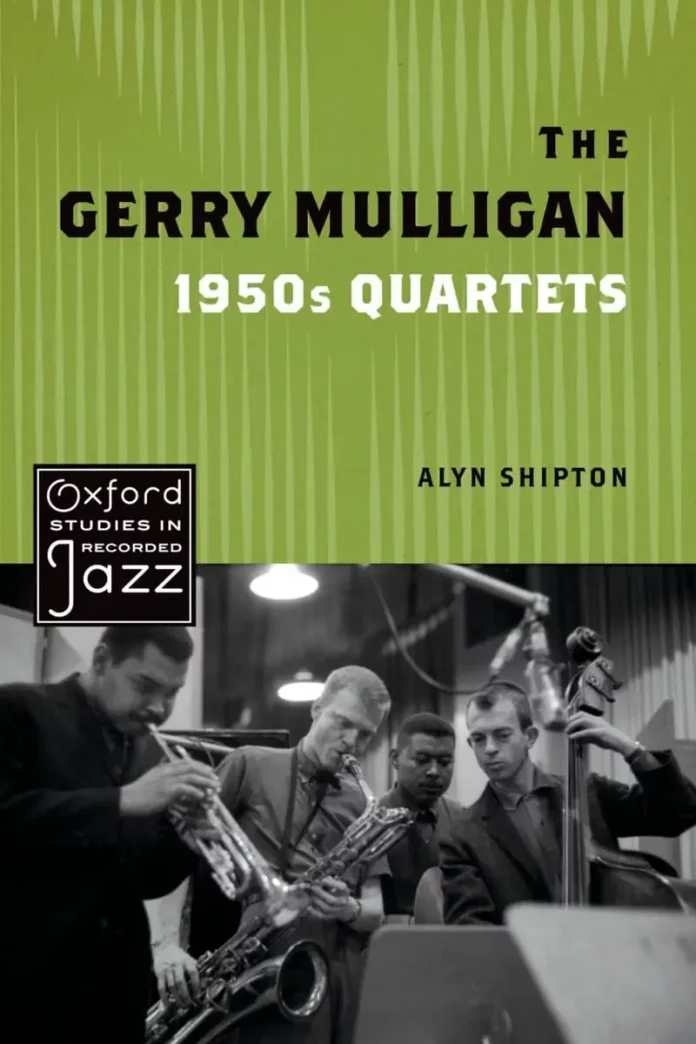With forensic attention to detail Alyn Shipton reveals fresh and original material about a group that created a totally new ensemble sound. Famously pianoless, the quartet was dominated by Gerry Mulligan’s baritone saxophone not only as a soloist but also as an accompanying voice.
In his preface, the author makes clear he was “fascinated by Mulligan’s playing, writing and band-leading” since his schooldays. The research he undertook in 2002 for a four-part series on Mulligan’s music for BBC Radio 3 allowed him to meet many “musicians and associates from all periods of his career”. His “comprehensive sweep through newspaper and magazine reports” uncovers much that is new in the quartet’s evolution.
Mulligan was born in Queens Village, Long Island on 6 April 1927 and the family lived a peripatetic life with homes in Ohio, New Jersey, Illinois and Michigan. Along the way he studied the clarinet and the saxophone with Sam Correnti and also had some piano lessons.
He began writing music when the family finally settled in Philadelphia; his professional career began in 1943 when Johnny Warrington accepted some of his charts. He was then taken on as a staff-arranger and occasional sideman for Tommy Tucker. He joined Elliot Lawrence’s band which was a “significant formative experience”. Lawrence used a French horn and tuba which was a prelude to the harmonic palette Mulligan enjoyed with Claude Thornhill and the Miles Davis nonet.
In 1946 he joined Gene Krupa, occasionally playing alto in the section. A year later he contributed one of the band’s biggest hits – Disc Jockey Jump. 1947 was the year he met Gil Evans, who recommended him to Claude Thornhill as another member of the writing team. Discussions took place in Evans’ apartment that led to the ground-breaking late-40s recording led by Miles Davis that became known as Birth Of The Cool. The author points out that around this time he was “introduced to heroin . . . by some of his New York colleagues”.
A friendship with Bob Weinstock led to Mulligan’s first recording as a leader in 1951 for the Prestige label. Prior to the date he had to rehearse the band in Central Park due to lack of funds. Later that year, along with his girlfriend Gail Madden, he hitchhiked across America, arriving in Los Angeles early in 1952. Their odyssey has become part of jazz folklore.
Mulligan started contributing scores to Stan Kenton while working at the Haig nightclub. After recruiting Chet Baker, Bob Whitlock and Chico Hamilton he recorded Bernie’s Tune and Lullaby Of The Leaves, which put the Pacific Jazz label on the map. The quartet “rapidly became a West Coast sensation (then) a national one during the first months of 1953” says Shipton. In February that year the group was the subject of a Time magazine article titled “Counterpoint Jazz”.
Three months later Mulligan married Arlyne Brown who was the daughter of songwriter Lew Brown and she soon took over as his manager until 1957. Shipton acknowledges her importance – in contrast to Sanford Josephson’s assessment in the disappointing Jeru’s Journey, which dismisses her in a few brief sentences. By early September the first edition of Mulligan’s quartet had come to a sudden halt. Having been convicted of heroin possession the leader spent the rest of 1953 in a low-security prison.
On his release he reformed with Bob Brookmeyer, Bill Anthony (soon to be replaced by Red Mitchell) and Frank Isola. Henri Renaud was so impressed when he heard them at the Blue Note in Philadelphia that he arranged for the quartet to appear at the Paris Jazz Fair in June 1954 for a series of successful concerts recorded by Vogue.
On its return to the States the quartet appeared at the first Newport Jazz Festival with Tony Fruscella, who had taken over from Brookmeyer. The introverted Fruscella did not last long. He was soon replaced by Jon Eardley who remained with the quartet as it evolved into an “extrovert, hard-blowing” sextet in 1955 with Brookmeyer and Zoot Sims. When the group disbanded Mulligan returned with Brookmeyer to the quartet format “that just like the sextet had honed its sound on the road and had a clear group identity”.
In 1957 Mulligan and Arlyne separated and Dave Bailey took over as the band’s manager. The following year he recruited Art Farmer, prompting Bailey to tell the author “I think it was the best quartet that Gerry Mulligan ever had.” Their few recordings together confirm this.
Alyn Shipton has much of interest to say about Mulligan’s late 50s recordings with Thelonious Monk, Stan Getz, Johnny Hodges, Ben Webster, Annie Ross and Paul Desmond. He also pays tribute to the Concert Jazz Band which won Downbeat’s award as the “Big Band of the Year” in 1961 – the year it disbanded. Apart from much diligent research The Gerry Mulligan 1950s Quartets benefits from a discography, a bibliography, copious transcriptions and several very rare photographs.
The Gerry Mulligan 1950s Quartets, by Alyn Shipton. Oxford University Press, 249pp. ISBN 9780197579763 (pb), ISBN 9780197579756 (hb).
















